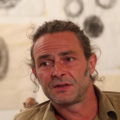The Voyage Through Appearances
FEBRUARY – MAY 2017
Mathilde has long been interested in the anthropological dimension of the societies that she is brought to encounter through her work, but also in their relationship to the myths and cosmogony at the foundation of some of their beliefs. Behind all this is the depth of the landscapes where live the men that require it—a depth both physical and psychological, and completely unfathomable, as one could already tell from her 2013 film with the evocative title: Focus on Infinity.
Here, the question of landscape is again central but is reconsidered by the artist who uses, for part of it, relatively diverse technical means. With TROPICS (“an allusion to the control tower, to space observation, and to the need for control that the human being develops in an environment like that of the Casa Proal,” she wrote), Mathilde Lavenne carries out a sort of transduction of the landscape.
Working from digital data, she uses a FARO scanner, a tool used in architecture to scan buildings. She installs this device on various sites and follows certain routes on the map, some of which she has tracked by foot to produce these stratified images, likened to “a kind of phantom map of the chosen site.” Then, from the myriad of points thus obtained, she renders a three-dimensional landscape. Thanks to this process, Mathilde has obtained a superimposition of layers that gives her progression along these paths lined with banana trees the appearance of a voyage through appearances, in the most literal sense. Nature looks like a laminate of finely meshed films that connect different surfaces of reality, which are not necessarily related to one another in our ordinary experiences.
The black and white shots could give the impression that the images were taken at night with infrared goggles except that here, the reversal of values and the greenish tone that characterize such images are precisely absent. The images give us the feeling of penetrating the structure of matter and reaching what usually remains invisible— with this work, we aren’t invited to discover a landscape that we don’t know but the very strangeness of the world of which it is only one element.
Gilles A. Tiberghien







